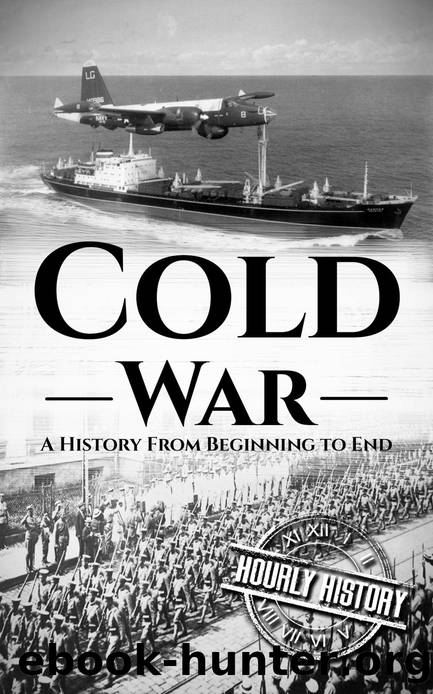Cold War: A History From Beginning to End (The Cold War) by Hourly History

Author:Hourly History [History, Hourly]
Language: eng
Format: epub
Publisher: Hourly History
Published: 2016-11-20T00:00:00+00:00
Chapter Four
The Culture of the Cold War
âThe reason we have such a high standard of living is because advertising has created an American frame of mind that makes people want more things, better things, and newer things.â
âNikita Khrushchev
In large part, because victory in the Cold War was so hard to define, it permeated every aspect of life in the United States and the Soviet Union especially. This included elements of culture: movies, television, music, literature, how people dressed and lived their lives, and much more.
Many Americans remember the Cold War as a battle between freedom and oppression on many levels, including culture. Ostensibly, Americans enjoyed freedoms of expression that were not open to Soviet citizens because the government kept tight control over what was produced and what people were exposed to. They were not completely wrong about that: The Soviet Union did strictly control the cultural creations in its country, and other Eastern Bloc and Communist countries (like China) did as well. In the Soviet Union and other Eastern Bloc countries, the government largely owned the media outlets and often pre-screened the products that they did not produce.
However, cultural expression was not as free and open as most Americans would like to have believed. While the American government did not own movie studios or dictate what could and could not be said directly, they did have their own means of controlling the cultural atmosphere. We have already read about the House Un-American Activities Committee, but America policed itself in subtle ways also. Americans adopted what historians call a âculture of conformity.â In essence, being different was dangerous, and men, women, and children all had strict expectations about how they should look and behave and live.
America saw itself as nothing if not the opposite of the Soviets. As Communism was on the far left of the political spectrum, America took a conservative turn in the wake of World War II that would last until the 1960s. Domestically, the âtraditionalâ family became the ideal. Men were expected to work full-time jobs and provide for their families. Women were responsible for caring for their homes and raising happy, healthy, ânormalâ children. Finally, children were expected to represent their parentsâ work honorably: be obedient, and grow up to fulfill their appropriate roles as men and women, husbands and wives.
As you have read, the end of World War II brought a renewed boom in the economy. War production turned into consumer production, and as white Americans returned to work, they were expected to buy. Since Communism was supposed to disregard materialism and consumer culture, America began to emphasize it. Happiness, in America, was expressed by what you owned. Consumerism was directly tied to the ideal of the âperfectâ family described above: A successful husband provided his wife and children with a home in the suburbs, the newest appliances, two cars, mass-produced foods, and all of the things not available to Soviet families. Thus, that perfect family expressed itself as much by what it owned as how its members behaved.
Download
This site does not store any files on its server. We only index and link to content provided by other sites. Please contact the content providers to delete copyright contents if any and email us, we'll remove relevant links or contents immediately.
| Africa | Americas |
| Arctic & Antarctica | Asia |
| Australia & Oceania | Europe |
| Middle East | Russia |
| United States | World |
| Ancient Civilizations | Military |
| Historical Study & Educational Resources |
Red Famine: Stalin's War on Ukraine by Anne Applebaum(2466)
Chernobyl by Serhii Plokhy(2129)
Midnight in Chernobyl by Adam Higginbotham(2080)
The House of Government by Slezkine Yuri(1846)
Midnight in Chernobyl: The Untold Story of the World's Greatest Nuclear Disaster by Adam Higginbotham(1776)
Red Shambhala by Andrei Znamenski(1749)
The Gulag Archipelago (Vintage Classics) by Aleksandr Solzhenitsyn(1727)
From Cold War to Hot Peace by Michael McFaul(1712)
All the Kremlin's Men by Mikhail Zygar(1698)
Putin's Labyrinth(1656)
Red Notice by Bill Browder(1593)
The Future Is History by Masha Gessen(1591)
From Russia with Lunch by David Smiedt(1551)
A People's Tragedy by Orlando Figes(1544)
The Romanovs by Simon Sebag Montefiore(1487)
How to Tame a Fox (and Build a Dog): Visionary Scientists and a Siberian Tale of Jump-Started Evolution by Lee Alan Dugatkin & Lyudmila Trut(1469)
Putin's Labyrinth: Spies, Murder, and the Dark Heart of the New Russia(1455)
The Lost Spy by Andrew Meier(1398)
Art and Revolution by John Berger(1386)
